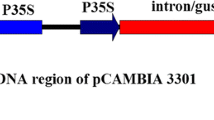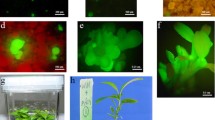Abstract
Lisianthus (Eustoma grandiflorum) is a cut or ornamental flower that is popular all over the world. This ornamental crop, however, lacks an effective weed control method due to its susceptibility to herbicide. In this study, transgenic plants of a lisianthus cultivar were produced using Agrobacterium-mediated delivery of the plasmid pCAMBIA3300, which carried the bialaphos resistance (bar) gene under driven by the CaMV 35S promoter. The transgenic calli were derived from wounded edges of the leaves grown on a shoot regeneration medium containing 100 mg l−1 cefotaxime and 2 mg l−1 glufosinate ammonium for 4 weeks. The callus that was detached from the wounded edge of the leaf was transferred to the shoot regeneration medium with 100 mg l−1 cefotaxime and 5 mg l−1 glufosinate ammonium for 4 weeks for shoot regeneration. The bar gene integration and expression in the transgenic plants were confirmed by Southern and Northern blot analyses, respectively. Subsequently, the transgenic lines were assessed in vitro and under greenhouse conditions for their resistance to the commercial herbicide Basta®, which contains glufosinate ammonium as the active component. Six transgenic lines showed high percentages (67–80%) of survival in vitro under the selection condition with glufosinate ammonium (up to 216 mg l−1). Under greenhouse conditions, the plants from these six lines remained healthy and exhibited a normal phenotype after spraying with glufosinate ammonium (up to 1,350 mg l−1). This is the first paper to provide a detailed survey of transgenic lisianthus expressing the bar gene and exhibiting herbicide-resistance under greenhouse conditions.




Similar content being viewed by others
Abbreviations
- CaMV:
-
Cauliflower mosaic virus
- BA:
-
6-benzyladenine
- NAA:
-
α-naphthaleneacetic acid
- PAT:
-
Phosphinothricin acetyltransferase
References
Aranovich D, Lewinsohn E, Zaccai M (2007) Post-harvest enhancement of aroma in transgenic lisianthus (Eustoma Grandiflorum) using the Clarkia breweri benzyl alcohol acetyltransferase (BEAT) gene. Postharvest Biol Technol 43:255–260
Bashir NS, Kalhor MR, Zarghani SN (2006) Detection, differentiation and phylogenetic analysis of Cucumber mosaic virus isolates from cucurbits in the northwest region of Iran. Virus Genes 32:277–288
Cho MA, Moon CY, Liu JR, Choi PS (2008) Agrobacterium-mediated transformation in Citrullus lanatus. Biol Plant 52:365–369
Choi YE, Jeong JH, In KJ, Yang DC (2003) Production of herbicide-resistant transgenic Panax ginseng through the introduction of the phosphinothricin acetyl transferase gene and successful soil transfer. Plant Cell Rep 21:563–568
D’Halluin K, De Block M, Denecke J, Janssens J, Leemans J, Reynaerts A, Botterman J (1992) The bar gene as selectable and screenable marker in plant engineering. In: Wu R (ed) Methods in enzymology, Vol 216 ‘Recombinant DNA’ Part C. Academic Press, New York, pp 415–426
Deroles SC, Marie Bredley J, Schwinn KE, Markham KR, Bloor S, Manson DG, Davies KM (1998) An antisense chalcone synthase cDNA leads to novel colour patterns in lisianthus (Eustoma grandiflorum) flower. Mol Breed 4:59–66
Fulton TM, Chunwongse J, Tanksley SD (1995) Microprep protocol for extraction of DNA from tomato and other herbaceous plants. Plant Mol Biol Rep 13:207–209
Furukawa H, Matsubara C, Shigematsu N (1990) Shoot regeneration from the roots of prairie gentian [Eustoma grandiflorum (Griseb.) Schinners]. Plant Tissue Cult Lett 7:11–13
Gamborg OL, Miller RA, Ojima K (1968) Nutrient requirements of suspension cultures of soybean root cells. Exp Cell Res 50:151–158
Griesbach RJ, Semeniuk P (1987) Use of somaclonal variation in the improvement of Eustoma grandiflorum. J Hered 78:114–116
Griesbach RJ, Semeniuk P, Roh M, Lawson RH (1988) Tissue culture in the improvement of Eustoma. HortScience 23:790–791
Halevy AH, Kofraneck AM (1984) Evaluation of Lisianthus as a new flower crop. HortScience 19:845–847
Handa T (1992) Regeneration and characterization of prairie gentian (Eustoma grandiflorum) plants transformed by Agrobacterium rhizogenes. Plant Tissue Cult Lett 9:10–14
Jones DR (2003) Plant viruses transmitted by whiteflies. Eur J Plant Pathol 109:195–219
Jones DR (2005) Plant viruses transmitted by thrips. Eur J Plant Pathol 113:119–157
Ledger SE, Deroles SC, Manson DG, Marie Bradley J, Given NK (1997) Transformation of lisianthus (Eustoma grandiflorum). Plant Cell Rep 16:853–858
Link AJ, Phillips D, Church GM (1997) Methods for generating precise deletions and insertions in the genome of wild-type Escherichia coli: application to open reading frame characterization. J Bacteriol 179:6228–6237
Mercuri A, Sacchetti A, De Benedetti L, Schiva T, Alberti S (2002) Green fluorescent flowers. Plant Sci 162:647–654
Murashige T, Skoog F (1962) A revised medium for rapid growth and bioassays with tobacco tissue cultures. Physiol Plant 15:473–497
Sambrook J, Fritsch EF, Maniatis T (1989) Molecular cloning: a laboratory manual, 2nd edn. Cold Spring Harbor Laboratory Press, New York
Semeniuk P, Griesbach RJ (1987) In vitro propagation of prairie gentian. Plant Cell Tissue Organ Cult 8:249–253
Semeria L, Allavena A (1993) Genetic transformation of Eustoma grandiflorum Griseb. In: Schiva T, Mercuri A (eds) Proceedings of the XVIIth Eucarpia Symposium “Creating genetic variation in ornamentals”, Ist Sper Floric, San Remo, Italy, March 1993, pp 247–249
Semeria L, Varia AM, Accotto GP, Allavena A (1995) Genetic transformation of Eustoma grandiflorum Griseb. by microprojectile bombardment. Euphytica 85:125–130
Semeria L, Ruffoni B, Rabaglio M, Genga A, Varia AM, Accotto GP, Allavena A (1996) Genetic transformation of Eustoma grandiflorum by Agrobacterium tumefaciens. Plant Cell Tissue Organ Cult 47:67–72
Sripaoraya S, Marchant R, Power JB, Davey MR (2001) Herbicide-tolerant transgenic pineapple (Ananas comosus) produced by microprojectile bombardment. Ann Bot 88:597–603
Takahashi M, Nishihara M, Yamamura S, Nishizawa S, Irifune K, Morikawa H (1998) Stable transformation of Eustoma grandiflorum by particle bombardment. Plant Cell Rep 17:504–507
Thiruvengadam M, Yang CH (2009) Ectopic expression of two MADS box genes from orchid (Oncidium Gower Ramsey) and lily (Lilium longiflorum) alters flower transition and formation in Eustoma grandiflorum. Plant Cell Rep 28:1463–1473
Yu TA, Yeh SD, Cheng YH, Yang JS (2000) Efficient rooting for establishment of papaya plantlets by micropropagation. Plant Cell Tiss Organ Cult 61:29–35
Zen S, Okuda M, Fuji S, Iwanami T (2008) The seasonal occurrence of viruliferous Thrips tabaci and the incidence of iris yellow spot virus disease on lisianthus. J Plant Pathol 90:511–515
Zhang Z, Xing A, Staswick P, Clemente TE (1999) The use of glufosinate as a selective agent in Agrobacterium-mediated transformation of soybean. Plant Cell Organ Cult 56:37–46
Author information
Authors and Affiliations
Corresponding author
Rights and permissions
About this article
Cite this article
Chen, YT., Fang, QS., Chiang, CH. et al. Transgenic Eustoma grandiflorum expressing the bar gene are resistant to the herbicide Basta® . Plant Cell Tiss Organ Cult 102, 347–356 (2010). https://doi.org/10.1007/s11240-010-9739-z
Received:
Accepted:
Published:
Issue Date:
DOI: https://doi.org/10.1007/s11240-010-9739-z




